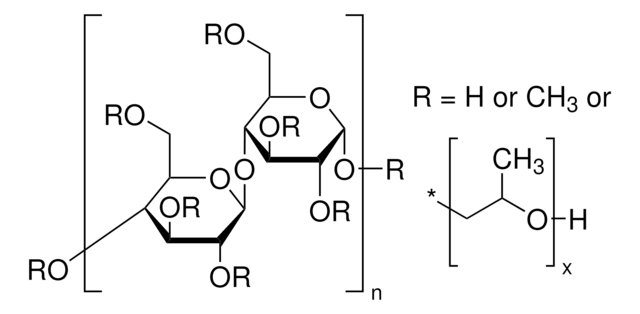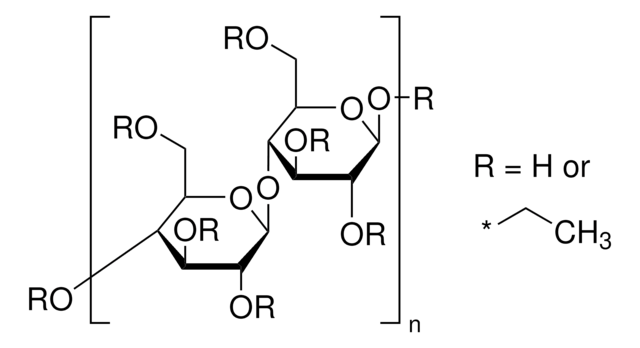191884
Hydroxypropyl cellulose
average Mw ~100,000, powder, 20 mesh particle size (99% through)
About This Item
Recommended Products
description
biological oxygen demand (BOD) 14,000 ppm
Quality Level
form
powder
autoignition temp.
752 °F
mol wt
average Mw ~100,000
impurities
<5 wt. %
particle size
20 mesh (99% through)
pH
5.0-8.5
interfacial tension mineral oil
12.5 dyn/cm, 0.1 wt. % in H2O (vs. mineral oil)
viscosity
65-175 cP, 5 wt. % in H2O(25 °C, Brookfield, spindle #1) (30 rpm)(lit.)
solubility
polar organic solvents: soluble
density
0.5 g/mL at 25 °C (lit.)
InChI
1S/C12H20N2/c1-5-12(13)11-7-6-10(14(3)4)8-9(11)2/h6-8,12H,5,13H2,1-4H3
InChI key
RRHXDYJWVYFMKV-UHFFFAOYSA-N
Looking for similar products? Visit Product Comparison Guide
Related Categories
General description
Application
- HPC is soluble in organic solvents which makes it suitable for the preparation of polymer gel electrolytes for electrochemical devices. The network-forming ability of HPC can improve the mechanical and electrical properties of gel electrolytes.
- Electrospun hydroxypropyl cellulose nanofibres can be used to develop drug delivery systems for a variety of hydrophobic drugs.
- Hydroxypropylcellulose combined with an effervescent agent like sodium carbonate can be usedas a binder and functional material to prepare floating tablets for thecontrolled release of ofloxacin.
Storage Class Code
11 - Combustible Solids
WGK
WGK 1
Flash Point(F)
Not applicable
Flash Point(C)
Not applicable
Personal Protective Equipment
Choose from one of the most recent versions:
Already Own This Product?
Find documentation for the products that you have recently purchased in the Document Library.
Customers Also Viewed
Our team of scientists has experience in all areas of research including Life Science, Material Science, Chemical Synthesis, Chromatography, Analytical and many others.
Contact Technical Service





